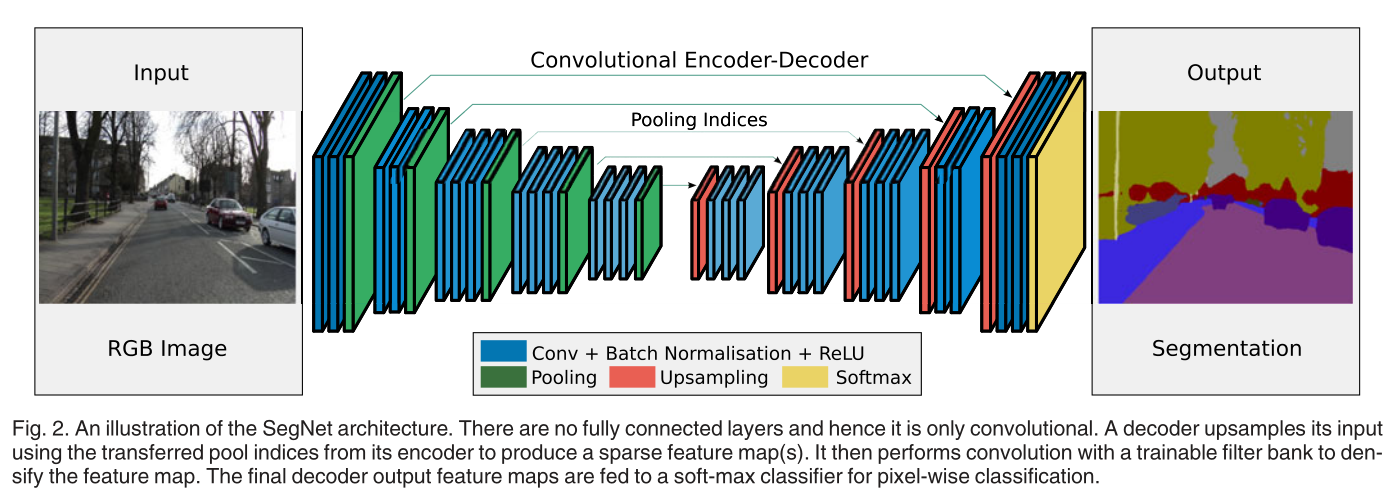SegNet网络的Pytorch实现
1.文章原文地址
SegNet: A Deep Convolutional Encoder-Decoder Architecture for Image Segmentation
2.文章摘要
语义分割具有非常广泛的应用,从场景理解、目标相互关系推断到自动驾驶。早期依赖于低水平视觉线索的方法已经快速的被流行的机器学习算法所取代。特别是最近的深度学习在手写数字识别、语音、图像中的分类和目标检测上取得巨大成功。如今有一个活跃的领域是语义分割(对每个像素进行归类)。然而,最近有一些方法直接采用了为图像分类而设计的网络结构来进行语义分割任务。虽然结果十分鼓舞人心,但还是比较粗糙。这首要的原因是最大池化和下采样减小了特征图的分辨率。我们设计SegNet的动机来自于分割任务需要将低分辨率的特征图映射到输入的分辨率并进行像素级分类,这个映射必须产生对准确边界定位有用的特征。
3.网络结构

4.Pytorch实现
import torch.nn as nn
import torch class conv2DBatchNormRelu(nn.Module):
def __init__(self,in_channels,out_channels,kernel_size,stride,padding,
bias=True,dilation=1,is_batchnorm=True):
super(conv2DBatchNormRelu,self).__init__()
if is_batchnorm:
self.cbr_unit=nn.Sequential(
nn.Conv2d(in_channels,out_channels,kernel_size=kernel_size,stride=stride,padding=padding,
bias=bias,dilation=dilation),
nn.BatchNorm2d(out_channels),
nn.ReLU(inplace=True),
)
else:
self.cbr_unit=nn.Sequential(
nn.Conv2d(in_channels, out_channels, kernel_size=kernel_size, stride=stride, padding=padding,
bias=bias, dilation=dilation),
nn.ReLU(inplace=True)
) def forward(self,inputs):
outputs=self.cbr_unit(inputs)
return outputs class segnetDown2(nn.Module):
def __init__(self,in_channels,out_channels):
super(segnetDown2,self).__init__()
self.conv1=conv2DBatchNormRelu(in_channels,out_channels,kernel_size=3,stride=1,padding=1)
self.conv2=conv2DBatchNormRelu(out_channels,out_channels,kernel_size=3,stride=1,padding=1)
self.maxpool_with_argmax=nn.MaxPool2d(kernel_size=2,stride=2,return_indices=True) def forward(self,inputs):
outputs=self.conv1(inputs)
outputs=self.conv2(outputs)
unpooled_shape=outputs.size()
outputs,indices=self.maxpool_with_argmax(outputs)
return outputs,indices,unpooled_shape class segnetDown3(nn.Module):
def __init__(self,in_channels,out_channels):
super(segnetDown3,self).__init__()
self.conv1=conv2DBatchNormRelu(in_channels,out_channels,kernel_size=3,stride=1,padding=1)
self.conv2=conv2DBatchNormRelu(out_channels,out_channels,kernel_size=3,stride=1,padding=1)
self.conv3=conv2DBatchNormRelu(out_channels,out_channels,kernel_size=3,stride=1,padding=1)
self.maxpool_with_argmax=nn.MaxPool2d(kernel_size=2,stride=2,return_indices=True) def forward(self,inputs):
outputs=self.conv1(inputs)
outputs=self.conv2(outputs)
outputs=self.conv3(outputs)
unpooled_shape=outputs.size()
outputs,indices=self.maxpool_with_argmax(outputs)
return outputs,indices,unpooled_shape class segnetUp2(nn.Module):
def __init__(self,in_channels,out_channels):
super(segnetUp2,self).__init__()
self.unpool=nn.MaxUnpool2d(2,2)
self.conv1=conv2DBatchNormRelu(in_channels,out_channels,kernel_size=3,stride=1,padding=1)
self.conv2=conv2DBatchNormRelu(out_channels,out_channels,kernel_size=3,stride=1,padding=1) def forward(self,inputs,indices,output_shape):
outputs=self.unpool(inputs,indices=indices,output_size=output_shape)
outputs=self.conv1(outputs)
outputs=self.conv2(outputs)
return outputs class segnetUp3(nn.Module):
def __init__(self,in_channels,out_channels):
super(segnetUp3,self).__init__()
self.unpool=nn.MaxUnpool2d(2,2)
self.conv1=conv2DBatchNormRelu(in_channels,out_channels,kernel_size=3,stride=1,padding=1)
self.conv2=conv2DBatchNormRelu(out_channels,out_channels,kernel_size=3,stride=1,padding=1)
self.conv3=conv2DBatchNormRelu(out_channels,out_channels,kernel_size=3,stride=1,padding=1) def forward(self,inputs,indices,output_shape):
outputs=self.unpool(inputs,indices=indices,output_size=output_shape)
outputs=self.conv1(outputs)
outputs=self.conv2(outputs)
outputs=self.conv3(outputs)
return outputs class segnet(nn.Module):
def __init__(self,in_channels=3,num_classes=21):
super(segnet,self).__init__()
self.down1=segnetDown2(in_channels=in_channels,out_channels=64)
self.down2=segnetDown2(64,128)
self.down3=segnetDown3(128,256)
self.down4=segnetDown3(256,512)
self.down5=segnetDown3(512,512) self.up5=segnetUp3(512,512)
self.up4=segnetUp3(512,256)
self.up3=segnetUp3(256,128)
self.up2=segnetUp2(128,64)
self.up1=segnetUp2(64,64)
self.finconv=conv2DBatchNormRelu(64,num_classes,3,1,1) def forward(self,inputs):
down1,indices_1,unpool_shape1=self.down1(inputs)
down2,indices_2,unpool_shape2=self.down2(down1)
down3,indices_3,unpool_shape3=self.down3(down2)
down4,indices_4,unpool_shape4=self.down4(down3)
down5,indices_5,unpool_shape5=self.down5(down4) up5=self.up5(down5,indices=indices_5,output_shape=unpool_shape5)
up4=self.up4(up5,indices=indices_4,output_shape=unpool_shape4)
up3=self.up3(up4,indices=indices_3,output_shape=unpool_shape3)
up2=self.up2(up3,indices=indices_2,output_shape=unpool_shape2)
up1=self.up1(up2,indices=indices_1,output_shape=unpool_shape1)
outputs=self.finconv(up1) return outputs if __name__=="__main__":
inputs=torch.ones(1,3,224,224)
model=segnet()
print(model(inputs).size())
print(model)
参考
https://github.com/meetshah1995/pytorch-semseg
SegNet网络的Pytorch实现的更多相关文章
- 群等变网络的pytorch实现
CNN对于旋转不具有等变性,对于平移有等变性,data augmentation的提出就是为了解决这个问题,但是data augmentation需要很大的模型容量,更多的迭代次数才能够在训练数据集合 ...
- U-Net网络的Pytorch实现
1.文章原文地址 U-Net: Convolutional Networks for Biomedical Image Segmentation 2.文章摘要 普遍认为成功训练深度神经网络需要大量标注 ...
- ResNet网络的Pytorch实现
1.文章原文地址 Deep Residual Learning for Image Recognition 2.文章摘要 神经网络的层次越深越难训练.我们提出了一个残差学习框架来简化网络的训练,这些 ...
- GoogLeNet网络的Pytorch实现
1.文章原文地址 Going deeper with convolutions 2.文章摘要 我们提出了一种代号为Inception的深度卷积神经网络,它在ILSVRC2014的分类和检测任务上都取得 ...
- AlexNet网络的Pytorch实现
1.文章原文地址 ImageNet Classification with Deep Convolutional Neural Networks 2.文章摘要 我们训练了一个大型的深度卷积神经网络用于 ...
- VGG网络的Pytorch实现
1.文章原文地址 Very Deep Convolutional Networks for Large-Scale Image Recognition 2.文章摘要 在这项工作中,我们研究了在大规模的 ...
- 【转载】PyTorch系列 (二):pytorch数据读取
原文:https://likewind.top/2019/02/01/Pytorch-dataprocess/ Pytorch系列: PyTorch系列(一) - PyTorch使用总览 PyTorc ...
- pytorch预训练
Pytorch预训练模型以及修改 pytorch中自带几种常用的深度学习网络预训练模型,torchvision.models包中包含alexnet.densenet.inception.resnet. ...
- PyTorch使用总览
PyTorch使用总览 https://blog.csdn.net/u014380165/article/details/79222243 深度学习框架训练模型时的代码主要包含数据读取.网络构建和其他 ...
随机推荐
- ajax页面刷新小错误(提交按钮type必须为button,而不能是submit)
背景: 使用ajax提交form表单时,提交按钮的type值写为了submit,导致ajax中回调函数中的提示信息toastr.success('提交数据成功');没有执行,只执行了alert语句 , ...
- Django_静态文件的配置(STATIC_URL)
静态文件,常用在head中,可动态的去检索settings里面的STATIC_URL = '/static/',然后做拼接settings.py中 STATIC_URL = '/static9/' # ...
- Intellij热部署插件JRebel的详细配置及图解
参考博客地址:https://blog.csdn.net/nyotengu/article/details/80629631 参考博客地址:https://blog.csdn.net/weixin_4 ...
- Android StickyListHeadersListView头部悬停 分组列表实现
最近在做分组列表,头部悬停的效果,在github上就搜到了StickyListHeaders(https://github.com/emilsjolander/StickyListHeaders)这个 ...
- Java中的IO流之输入流|乐字节
亲爱的乐字节的小伙伴们,小乐又来分享Java技术文章了.上一篇写到了IO流,这篇文章着重 谈谈输入流,再下次再说输出流. 点击回顾上一篇:乐字节Java之file.IO流基础知识和操作步骤 一. 输入 ...
- java war包 远程debug出现的问题解决,学会查看日志
开启远程debug之后,8005 关闭tomcat 又启动不了了.. netstat -lnp 未发现8005接口 eclipse 内远程链接到服务器,debug 下发现服务器线程启动也存在问题.很多 ...
- golang开发:环境篇(四)包管理器 glide的使用
glide 是golang项目开发中是特别重要的软件,没有它,golang的项目可能都无法发布. 为什么要使用glide 平时我们开发Go项目的时候,使用第三方的包的时候都直接使用go get 去获取 ...
- 多线程面试题之【三线程按顺序交替打印ABC的方法】
建立三个线程,线程名字分别为:A.B.C,要求三个线程分别打印自己的线程名字,但是要求三个线程同时运行,并且实现交替打印,即按照ABCABCABC的顺序打印.打印10轮,打印完毕控制台输出字符串:&q ...
- jQuery控制页面滚动条上下滚动
.向上滚动 $(); .向下滚动 $(); 参数解读:$(this)表示要实现上下滚动的对象,-50表示向上滚动50px , +50表示向下滚动50px ,1000表示滚动速度
- ELK搜索条件
1.要搜索一个确切的字符串,即精确搜索,需要使用双引号引起来:path:”/app/logs/nginx/access.log” 2.如果不带引号,将会匹配每个单词:uid token 3.模糊搜索: ...
